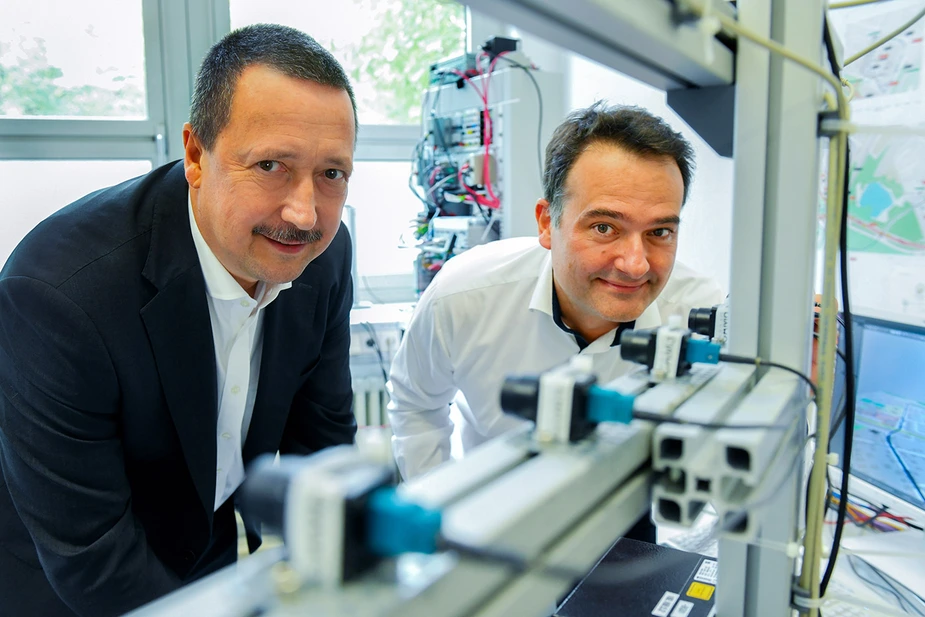Battery electric buses and self-driving trams
The future has already arrived at Siemens Mobility in Adlershof
When the first self-driving tram whooshes towards us, it looks like an ordinary tram riddled with cameras, sensors, radars and laser scanners. It is the most recent feat of the development department at Siemens Mobility, which also includes engineers from Adlershof. These engineers work on novel mobility solutions: electric busses that recharge when they reach their final stop, and trucks that run on current collectors over a motorway without their diesel engines polluting the air.
Eighty-five employees as well as 30 working students and external staff work at Siemens Mobility in Adlershof. “We are driven by a thirst for the new,” says Frank Voss, the head of the Adlershof branch. “We have been working together with universities for over 25 years. Students are a building block of our success.” The company’s engineers managed to develop the self-driving tram in the course of only one year. This involved developing a simulated world and testing the sensors in the lab. Accelerating, braking, reacting to obstacles – everything happens automatically. The smart tram takes note of everything going on around it. The 40-ton prototype vehicle is currently being tested in the real-life traffic of Potsdam, where it is using a six-kilometre section of the city’s public transport network.
Unlike a subway, which runs in an independent and self-contained network, the self-driving tram must deal with moving traffic, which is why there is always a second sensor that serves to confirm any (warning) signals. Six cameras scan the tram’s surroundings. They are complemented by lidars, radars and camera sensors. Additionally, the roof of the tram is equipped with GPS receiver. In a concerted effort, these instruments detect and discern cars, motorbikes, and pedestrians. The trams can also analyse the speed and trajectory of any given obstacle. The resulting data is analysed in real-time: could the obstacle hit the tram in five seconds? While radars may detect objects, they are not able to see them in detail. Cameras create high-detail images but cannot measure distance. “The key to autonomous driving is to bring all the available data together,” says Voss.
The development of such systems requires the skills of programmers, image engineers, and artificial intelligence experts. In complex networks, electric engineering, mathematics, computers and robotics play an important role as well as machine engineering and control technology. Working together with human tram drivers is important to find out: how does a human do it? “If we know all the details and take them into account, we can bring a machine to life,” says Voss.
The use of such advanced driver assistance systems, as the experts call them, is now also being tested in long-distance trains. Many of the components of those future products will be “made in Adlershof.”
In addition to driver assistance systems, Siemens Mobility in Adlershof is also working on the so-called eHighway pantograph, which was recently presented at the IAA in Hanover in cooperation with Scania. Similar to trams, trucks use a current collector above the motorway but they use two poles and drive at 90 kilometres an hour. In 2019, these hybrid trucks will be tested on a 5-kilometre segment of the motorway between Darmstadt and Frankfurt/Main. When the trucks approach the respective section, they turn off their diesel engines, switch to electricity, and recharge their batteries. In the long term, the plan is to make the batteries work for long enough for the trucks to make “the last mile” on the road to the customer.
Lastly, the Siemens researchers in Adlershof are working on high power charging of electric busses. There are some bus lines in Hamburg and other cities that already use the technology. At the last stop of the line, the batteries recharge in just a few minutes and last until the bus reaches the last stop again. The Berliner Verkehrsbetriebe (BVG), one of Berlin’s public transportation companies, is also bidding adieu to the dirty diesel technology and testing the new technology at its EUREF-Campus.
By Kathrin Reisinger for Adlershof Journal
